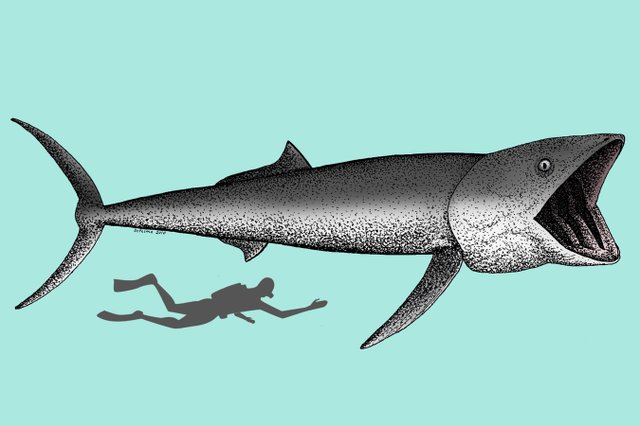 Researchers published in the journal Science have dusted off fossils uncovered 40 years ago by the Marion Bonner family in western Kansas and found a new genus of giant plankton-eating bony fish among them.
Researchers published in the journal Science have dusted off fossils uncovered 40 years ago by the Marion Bonner family in western Kansas and found a new genus of giant plankton-eating bony fish among them.
Filter-feeding fish known as pachycormids were previously thought to have been a brief phase in evolutionary history, appearing 170 million years ago and then leaving the scene until whales, sharks and rays stepped into the niche 56 million years ago.
The new finds suggest that instead the pachycormids were a hugely successful species who set up shop in oceans all over the world from 170 million years ago until 65 million years ago, when the K-T extinction event that killed the dinosaurs killed them (and most everything else on earth) too.
Co-author Kenshu Shimada, a research associate in paleontology at the Sternberg Museum of Natural History, told Discovery News that one of the fish he and his colleagues identified, Bonnerichthys, grew to around 20 feet in length and swam through a seaway covering what is today the state of Kansas. […]
For the study, led by University of Oxford scientist Matt Friedman, the researchers analyzed both old and new fish fossils found in England, the U.S. and Japan. The Kansas fish was previously thought to have been like a gigantic swordfish, bearing fang-like teeth on its jawbones.
“However, our close examination of the specimen showed that such a long snout and fang-like teeth were not present in the fish,” Shimada said. “Rather, with a blunt massive head, the fish had long toothless jawbones and long gill-supporting bones that are characteristic of plankton-feeding fishes.”
The European Jurassic species Leedsichthys was even larger at 30 feet. Their huge mouths were an asset in keeping their even huger bodies fed off tiny plankton. Like baleen whales today, pachycormids opened their mouths wide and gulped as much water as they could, filtering the plankton-packed water through its gills.
There’s some great background on the fossil-hunting Bonner family in this article.
Over the seven decades that Marion climbed and combed the chalk buttes; and over the four decades his children accompanied him, the Bonners helped science immeasurably. They were resourceful and careful; when they found unusual-looking bones, they gave them to scientists and let them take published credit for the scientifically described “discoveries.”
Their discoveries lay now in museums in Kansas, Chicago, Los Angeles and elsewhere. Grateful scientists named discoveries after the family: A few invertebrates. Pecten bonneri, a small-fin fish, pterandon bonneri, a flying reptile, niobrarateuthis bonneri, an ancient squid, found by Melanie.
This is their first genus, though.

Ironic, given the fact that Kansas is one of those states where like 80% of the population thinks the earth is 6,000 years old.
😆 All you need is one extraordinarily fertile family to pwn 60% of the state.
I’ve got to stand up for my old home state, as I used to live, work, and study in Kansas (at the U of Kansas in Lawrence, in the NE of the state just about half an hour’s drive from Topeka and 45 minutes from Kansas City).
The creationism in Kansas stories came about because of a well-known tactic that opponents have come to call “stealth creationism”. This is especially true of the second time they tried to push a creationist agenda on the state. The first time, it took a couple of years, but in 2001 challengers in the state Republican primaries replaced the pro-creationism stealth candidates and voted in a curriculum that explicitly included evolution and the origin and age of the earth again.
In 2004, there was a stealth creationist majority again that ran candidates and basically existed only to push the creationist agenda. I was actually in Kansas for this one, just 30 minutes’ drive from the state capital, as I noted above. From this proximity, I was able to attend the state BoE hearings and see how much the creationist majority simply ran roughshod over popular opinion, not just from the professors and teachers in the area, but also from parents and the general public at every hearing. The new pro-IDC standards were approved in 2005, and the following year everyone who was up for re-election who voted for that was defeated in primary challenges by other Republicans.
The only reason these situations came about is because Kansas is a heavily Republican state, so any Republican candidate for state BoE who wins the primary election is practically guaranteed a seat. But if the general public wanted creationism in its schools then it wouldn’t be necessary to run stealth campaigns, nor would the candidates constantly be defeated at the primary stage as soon as their terms were up. If Kansans wanted creationism, then they’d just brave the public ridicule, which didn’t have any affect on anybody at the time, even the supporters of proper science, and keep their creationist BoE members.
And on a happier topic, there was a book that came out while I was living in Kansas called Oceans of Kansas: A Natural History of the Western Interior Sea by Michael J. Everhart of the Sternberg Natural History Museum. It’s a book I can recommend highly. :yes:
Thank you for the nuanced explanation, Null. That was enlightening. :thanks:
Yes, thank you. I apologize for my sweeping generalization. My family is from neighboring Missouri, where crazy legislative agendas often run roughshod over the public will, also.